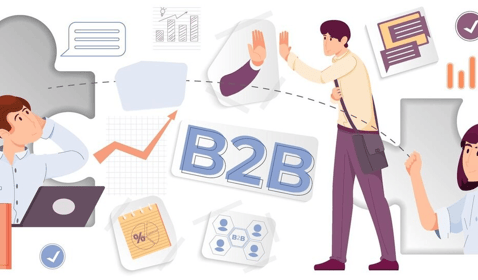Solutions


















B2B Marketing
Business-to-Business (B2B) Marketing refers to the strategies and tactics employed by companies to market their products or services to other businesses rather than to individual consumers. Unlike Business-to-Consumer (B2C) marketing, which focuses on end-users, B2B marketing aims to engage and build relationships with other businesses that can benefit from your offerings.
Key Characteristics of B2B Marketing:
Target Audience: The primary audience consists of other businesses, including their decision-makers, such as procurement officers, managers, and executives. Understanding their specific needs and challenges is crucial for effective marketing.
Longer Sales Cycles: B2B transactions often involve more complex decision-making processes, longer sales cycles, and larger deals compared to B2C. Marketing efforts must account for this extended timeline and focus on nurturing leads through multiple stages of the buyer’s journey.
Relationship Building: Building and maintaining strong relationships is central to B2B marketing. Trust and credibility play significant roles, and strategies often emphasize creating valuable connections and providing exceptional customer service.
Value Proposition: B2B marketing emphasizes demonstrating the value and ROI of products or services. It involves showcasing how your solutions address business problems, improve efficiency, or contribute to achieving strategic goals.
Content Marketing: Content plays a pivotal role in B2B marketing. Companies use educational content, such as white papers, case studies, webinars, and blog posts, to inform, engage, and influence decision-makers throughout their buying journey.
Account-Based Marketing (ABM): ABM is a targeted approach where marketing efforts are customized for specific high-value accounts. It involves personalized messaging and strategies designed to address the unique needs of each target business.
Lead Generation and Nurturing: Generating high-quality leads and nurturing them through tailored communication is essential. Techniques such as email marketing, SEO, and PPC are commonly used to attract and engage potential business clients.
Analytics and Metrics: B2B marketing relies heavily on data and analytics to measure campaign effectiveness, track ROI, and make informed decisions. Metrics such as lead conversion rates, customer acquisition costs, and lifetime value are critical for assessing performance.
Why B2B Marketing Matters
Effective B2B marketing drives business growth by reaching out to other companies that need your products or services. It helps establish your brand as an industry leader, build strong business relationships, and ultimately, contribute to long-term success and profitability. In a competitive marketplace, a strategic B2B marketing approach can differentiate your business, attract and retain valuable clients, and achieve sustainable growth.
In Summary
B2B marketing is a specialized discipline focused on fostering relationships between businesses and delivering value through tailored strategies. By understanding your target audience, leveraging content, and using data-driven approaches, you can effectively position your company for success in the B2B landscape.
D2C marketing
Direct-to-Consumer (D2C) Marketing refers to the strategy where brands and businesses sell their products or services directly to end consumers without intermediaries such as wholesalers or retailers. This approach allows companies to build a direct relationship with their customers, control their brand experience, and capture higher margins.
Key Characteristics of D2C Marketing:
1. Direct Engagement: D2C marketing focuses on establishing a direct connection with consumers through various channels such as online stores, social media, and email. This direct engagement allows for personalized interactions and tailored marketing strategies.
2. Brand Control: By selling directly to consumers, brands have full control over their messaging, branding, and customer experience. This control extends to every touchpoint, from product presentation to customer service.
3. Customer Data: D2C marketing provides valuable insights into customer behavior, preferences, and purchasing patterns. Brands can leverage this data to make informed decisions, personalize marketing efforts, and improve their products or services.
4. E-Commerce Integration: D2C marketing often involves robust e-commerce platforms that facilitate online transactions. These platforms are designed to provide a seamless shopping experience, including features like personalized recommendations, easy checkout processes, and efficient order fulfillment.
5. Content and Social Media: Content marketing and social media play pivotal roles in D2C strategies. Brands use engaging content, influencer partnerships, and social media campaigns to attract, educate, and retain customers.
6. Customer Experience: Enhancing the customer experience is a core focus of D2C marketing. Brands strive to provide exceptional service, from user-friendly website design to responsive customer support, to foster loyalty and repeat business.
7. Personalization: Personalization is a key element in D2C marketing. Brands use data to tailor their offers, recommendations, and communications to individual preferences, increasing relevance and engagement.
8. Brand Loyalty and Advocacy: D2C marketing aims to build strong brand loyalty by creating memorable experiences and delivering value. Satisfied customers are more likely to become brand advocates, promoting the brand through word-of-mouth and social sharing.
Why D2C Marketing Matters
D2C marketing empowers brands to bypass traditional retail channels and engage directly with their customers. This approach not only enhances brand control and customer relationships but also enables companies to capture more value from their sales. By leveraging customer data, personalizing experiences, and optimizing their online presence, D2C brands can achieve greater profitability, drive growth, and establish a strong market presence.
In Summary
Direct-to-Consumer (D2C) marketing represents a modern approach where brands connect directly with their customers, bypassing traditional intermediaries. Through effective e-commerce strategies, personalized content, and a focus on customer experience, D2C marketing allows businesses to build strong relationships, enhance brand loyalty, and drive sustainable growth.
B2C Marketing
Business-to-Consumer (B2C) Marketing refers to the strategies and tactics used by businesses to promote and sell their products or services directly to individual consumers. Unlike Business-to-Business (B2B) marketing, which targets other businesses, B2C marketing focuses on engaging with end-users and addressing their personal needs and desires.
Key Characteristics of B2C Marketing:
1. Target Audience: The primary audience consists of individual consumers rather than businesses. Understanding consumer behavior, preferences, and purchasing motivations is crucial for effective B2C marketing.
2. Emotional Appeal: B2C marketing often appeals to emotions, desires, and aspirations. Campaigns are designed to create a connection with consumers, influence their purchasing decisions, and foster brand loyalty.
3. Shorter Sales Cycle: Compared to B2B marketing, B2C sales cycles are generally shorter. Consumers make purchase decisions more quickly and with fewer decision-makers involved.
4. Mass Marketing Techniques: B2C marketing frequently employs mass marketing techniques, including advertising on television, radio, social media, and other channels to reach a broad audience.
5. Content Marketing: Content plays a significant role in B2C marketing. Brands create engaging content such as blog posts, videos, social media updates, and influencer partnerships to attract and retain consumers.
6. Promotions and Discounts: Special offers, promotions, and discounts are commonly used to drive consumer purchases. Time-limited deals, loyalty programs, and seasonal sales are effective strategies to stimulate demand.
7. Online and Offline Channels: B2C marketing leverages both online and offline channels to reach consumers. This includes e-commerce websites, mobile apps, physical retail stores, and direct mail.
8. Customer Experience: Providing an exceptional customer experience is central to B2C marketing. Brands focus on creating seamless shopping experiences, excellent customer service, and personalized interactions to enhance satisfaction and loyalty.
Why B2C Marketing Matters
B2C marketing is essential for driving consumer engagement, brand awareness, and sales. By effectively reaching and resonating with individual consumers, businesses can build strong relationships, foster loyalty, and achieve sustained growth. Understanding consumer needs and preferences, leveraging emotional appeal, and utilizing diverse marketing channels are key to success in the B2C landscape.
In Summary
Business-to-Consumer (B2C) marketing focuses on engaging and selling directly to individual consumers. It involves understanding consumer behavior, creating emotionally compelling campaigns, and leveraging various marketing channels to drive sales and build brand loyalty. By providing a great customer experience and effectively targeting the right audience, B2C marketing helps businesses achieve growth and maintain a competitive edge.
Lead Generation
Lead Generation with Performance Marketing involves using data-driven strategies and measurable tactics to attract and convert potential customers into leads. Performance marketing focuses on achieving specific, quantifiable outcomes, such as clicks, conversions, and leads, making it a highly effective approach for generating high-quality leads.
Key Components of Lead Generation through Performance Marketing:
Defining Goals and KPIs:
Objective Setting: Clearly define your lead generation goals, such as the number of leads, cost per lead (CPL), and lead quality.
Key Performance Indicators (KPIs): Identify KPIs to measure the effectiveness of your campaigns, such as conversion rates, click-through rates (CTR), and return on ad spend (ROAS).
Targeted Advertising:
Pay-Per-Click (PPC) Campaigns: Use PPC platforms like Google Ads and Bing Ads to run targeted ads that drive traffic to your lead capture pages. Bid on relevant keywords and optimize ad copy for high relevance and engagement.
Social Media Advertising: Leverage social media platforms such as Facebook, LinkedIn, and Instagram to run targeted ad campaigns. Use advanced targeting options to reach specific audience segments based on demographics, interests, and behaviors.
Landing Pages and Lead Forms:
Optimized Landing Pages: Create high-converting landing pages tailored to your ad campaigns. Ensure the landing page content aligns with the ad messaging and includes a clear, compelling call-to-action (CTA).
Lead Capture Forms: Design lead capture forms that are simple and easy to complete. Collect essential information while minimizing friction to maximize form submissions.
Data-Driven Insights:
Performance Tracking: Utilize analytics tools to monitor the performance of your lead generation campaigns. Track metrics such as click-through rates, conversion rates, and cost per lead to evaluate effectiveness.
A/B Testing: Conduct A/B tests on ad copy, landing pages, and CTAs to determine what works best. Use data from these tests to optimize your campaigns for better results.
Lead Nurturing and Follow-Up:
Automated Workflows: Implement marketing automation tools to set up automated email sequences and follow-up actions based on lead behavior and engagement.
Personalized Communication: Use the information gathered from leads to tailor follow-up communication, ensuring it is relevant and addresses their specific needs or interests.
Budget Optimization:
Bid Management: Optimize your bidding strategies to achieve the best results within your budget. Adjust bids based on performance data to improve cost efficiency and maximize ROI.
Campaign Scaling: Scale successful campaigns by increasing budget allocation to high-performing channels and reducing spend on underperforming ones.
Lead Quality and Scoring:
Lead Scoring: Implement lead scoring models to evaluate and prioritize leads based on their likelihood to convert. Focus your efforts on high-quality leads that are more likely to generate sales.
Continuous Improvement: Regularly review lead quality and campaign performance to make data-driven adjustments and improve overall lead generation strategies.
Why Lead Generation with Performance Marketing Matters
Lead generation through performance marketing is highly effective because it focuses on achieving measurable results and optimizing campaigns based on data. By leveraging targeted advertising, optimized landing pages, and data-driven insights, businesses can generate high-quality leads more efficiently and cost-effectively. Performance marketing allows for continuous optimization and refinement, ensuring that lead generation efforts are aligned with business goals and delivering a strong return on investment.
Customer Retention
Customer Retention in Performance Marketing involves leveraging data-driven marketing strategies and measurable tactics to keep existing customers engaged, satisfied, and loyal. Performance marketing focuses on achieving specific, quantifiable results, and applying these principles to retention can lead to improved customer loyalty and long-term business success.
Key Strategies for Customer Retention in Performance Marketing:
Data-Driven Personalization:
Customer Segmentation: Utilize data to segment your customer base into distinct groups based on behavior, purchase history, and preferences. This segmentation allows for more targeted and relevant marketing efforts.
Personalized Campaigns: Create personalized marketing campaigns tailored to each segment. Use customer data to craft messages, offers, and recommendations that resonate with individual preferences and needs.
Targeted Retargeting:
Retargeting Ads: Implement retargeting campaigns to re-engage customers who have interacted with your brand but have not recently made a purchase. Display personalized ads based on their previous interactions to encourage them to return.
Dynamic Ads: Use dynamic retargeting ads that showcase products or services customers have previously viewed, enhancing relevance and increasing the likelihood of conversion.
Performance Metrics and Analytics:
Customer Retention Rate: Track and analyze retention rates to measure how well you are maintaining customer loyalty. This metric helps assess the effectiveness of your retention strategies.
Lifetime Value (CLV): Monitor the customer lifetime value to understand the long-term value each customer brings. Use this data to optimize retention efforts and allocate resources effectively.
Automated Email Campaigns:
Trigger-Based Emails: Set up automated email campaigns that trigger based on customer behavior, such as abandoned carts, purchase anniversaries, or inactivity. These emails should include personalized content and offers to re-engage customers.
Nurturing Sequences: Create nurturing email sequences that provide ongoing value, such as exclusive content, product updates, or loyalty rewards. These sequences help maintain customer interest and engagement.
Loyalty and Rewards Programs:
Performance-Driven Rewards: Develop loyalty programs that reward repeat purchases and engagement. Use performance marketing data to design rewards that align with customer preferences and drive desired behaviors.
Referral Incentives: Implement referral programs that incentivize existing customers to refer new customers. Track performance metrics to evaluate the effectiveness of referral strategies.
Customer Feedback and Engagement:
Surveys and Feedback Forms: Regularly solicit feedback from customers through surveys and feedback forms. Use performance marketing data to identify trends and address any issues that may impact retention.
Engagement Tactics: Engage with customers through social media, forums, and other online platforms. Respond to comments and inquiries promptly to build stronger relationships and address concerns.
A/B Testing and Optimization:
Campaign Testing: Conduct A/B tests on various elements of your retention campaigns, including email subject lines, ad copy, and offers. Use data-driven insights to optimize and improve campaign performance.
Continuous Improvement: Regularly analyze performance metrics and adjust strategies based on results. Focus on improving retention tactics that yield the best results and addressing any areas that need enhancement.
Cross-Channel Integration:
Unified Experience: Ensure a consistent and cohesive customer experience across all marketing channels, including email, social media, and advertising. Integrate data from multiple channels to provide a unified approach to retention.
Omnichannel Strategy: Implement an omnichannel retention strategy that leverages multiple touchpoints to engage customers. Use performance data to coordinate efforts and create a seamless experience.
Why Customer Retention Matters in Performance Marketing
Customer retention is crucial in performance marketing because retaining existing customers is often more cost-effective than acquiring new ones. By applying performance marketing principles to retention efforts, businesses can optimize their strategies, enhance customer engagement, and improve ROI. Data-driven insights and targeted campaigns ensure that retention efforts are effective, measurable, and aligned with business objectives.
In Summary
Customer retention in performance marketing involves applying data-driven, measurable strategies to keep existing customers engaged and loyal. By leveraging personalized campaigns, targeted retargeting, automated email sequences, and loyalty programs, businesses can enhance retention efforts and drive long-term success. Performance metrics and continuous optimization ensure that retention strategies are effective and aligned with overall marketing goals.
Brand Awareness
Brand Awareness in Performance Marketing involves using data-driven and measurable strategies to increase the visibility and recognition of a brand among its target audience. While performance marketing traditionally focuses on measurable outcomes like conversions and ROI, applying these principles to brand awareness can drive significant results by leveraging targeted, cost-effective tactics.
Key Strategies for Building Brand Awareness through Performance Marketing:
Targeted Advertising:
Pay-Per-Click (PPC) Campaigns: Use PPC advertising on platforms such as Google Ads and Bing Ads to drive traffic to your brand’s website. Optimize ad campaigns with relevant keywords, compelling ad copy, and strong calls-to-action (CTAs) to maximize visibility.
Social Media Ads: Leverage social media platforms like Facebook, Instagram, LinkedIn, and Twitter to run targeted ad campaigns. Utilize demographic, interest-based, and behavioral targeting to reach your ideal audience and enhance brand recognition.
Content Marketing and Distribution:
High-Quality Content: Create engaging and valuable content that highlights your brand’s unique value proposition. This can include blog posts, videos, infographics, and case studies that resonate with your target audience.
Paid Content Promotion: Use performance marketing techniques to promote your content through paid channels, including sponsored posts, native advertising, and content discovery platforms like Outbrain or Taboola.
Performance Metrics and Analytics:
Impressions and Reach: Track metrics such as impressions and reach to measure how many people have seen your brand’s ads or content. These metrics help gauge the effectiveness of your brand awareness campaigns.
Engagement Metrics: Monitor engagement metrics such as likes, shares, comments, and click-through rates (CTR) to assess how well your content resonates with your audience and to optimize campaigns accordingly.
Retargeting and Remarketing:
Brand Recall: Implement retargeting campaigns to remind previous visitors of your brand. Use ads that reinforce your brand message and encourage further interaction or conversion.
Sequential Retargeting: Create sequential retargeting strategies to present a series of ads that gradually build brand awareness and familiarity over time.
Influencer and Affiliate Marketing:
Influencer Partnerships: Collaborate with influencers who align with your brand values and have a strong following within your target market. Influencers can help increase brand visibility and credibility through authentic endorsements.
Affiliate Programs: Develop an affiliate marketing program to leverage partnerships with affiliates who promote your brand in exchange for a commission on sales. This can expand your brand’s reach and drive traffic to your website.
A/B Testing and Optimization:
Campaign Testing: Conduct A/B testing on various ad creatives, headlines, and targeting options to determine which elements are most effective at building brand awareness. Use performance data to optimize and refine your campaigns.
Continuous Improvement: Regularly analyze performance metrics and adjust strategies based on insights. Focus on optimizing high-performing campaigns and addressing any areas that need improvement.
Cross-Channel Integration:
Unified Messaging: Ensure consistent brand messaging across all marketing channels, including paid search, social media, and display advertising. A unified approach helps reinforce brand identity and increases recognition.
Omnichannel Approach: Implement an omnichannel strategy that integrates various touchpoints to create a cohesive brand experience. Use data from multiple channels to enhance targeting and drive brand awareness.
Engagement and Interaction:
Interactive Content: Create interactive content such as polls, quizzes, and contests to engage your audience and boost brand visibility. Interactive elements can increase participation and spread brand awareness organically.
Community Building: Foster an online community around your brand through social media groups, forums, or branded content. Engage with your audience to build strong relationships and increase brand loyalty.
Why Brand Awareness Matters in Performance Marketing
Building brand awareness is essential for driving long-term success and achieving sustainable growth. Performance marketing strategies focused on brand awareness help increase visibility, attract new audiences, and establish a strong market presence. By leveraging targeted advertising, high-quality content, and data-driven insights, businesses can effectively enhance brand recognition and influence consumer perceptions.
Data Analytics
Data Analytics with Performance Marketing refers to the use of data-driven insights and analytical tools to optimize and measure the effectiveness of marketing campaigns. Performance marketing focuses on achieving specific, quantifiable outcomes, and leveraging data analytics helps marketers make informed decisions to enhance campaign performance, maximize ROI, and drive business growth.
Key Aspects of Integrating Data Analytics with Performance Marketing:
Defining Key Metrics and KPIs:
Objective Setting: Establish clear objectives for your performance marketing campaigns, such as lead generation, conversion rates, or customer acquisition cost (CAC).
Key Performance Indicators (KPIs): Identify relevant KPIs to measure success, including click-through rates (CTR), cost per click (CPC), return on ad spend (ROAS), and customer lifetime value (CLV).
Data Collection and Integration:
Tracking Tools: Implement tracking tools and technologies, such as Google Analytics, Adobe Analytics, or marketing automation platforms, to collect data on user behavior, campaign performance, and conversion metrics.
Data Integration: Integrate data from various sources, including social media, paid search, email marketing, and web analytics, to get a comprehensive view of campaign performance.
Performance Analysis and Reporting:
Real-Time Analytics: Use real-time data analytics to monitor campaign performance as it happens. Analyze metrics such as traffic, engagement, and conversions to make timely adjustments.
Custom Reports: Create custom reports to visualize key metrics and performance trends. Use dashboards and visualization tools to present data in an easily understandable format for stakeholders.
Audience Segmentation and Targeting:
Behavioral Analysis: Analyze user behavior to segment your audience based on demographics, interests, and purchasing patterns. Use these insights to create targeted and personalized marketing campaigns.
Lookalike Audiences: Utilize data analytics to identify lookalike audiences that resemble your best customers. This can help expand your reach and target new prospects with similar characteristics.
Campaign Optimization:
A/B Testing: Conduct A/B testing on various elements of your marketing campaigns, such as ad copy, visuals, and landing pages. Analyze results to determine the most effective components and optimize your campaigns accordingly.
Bid Management: Use data insights to optimize bid strategies for paid advertising. Adjust bids based on performance data to improve cost-efficiency and achieve better results.
Customer Journey Mapping:
Path Analysis: Analyze the customer journey to understand how users interact with your brand across different touchpoints. Identify key stages in the conversion funnel and optimize each stage to enhance user experience and drive conversions.
Conversion Attribution: Implement attribution models to determine which marketing channels and touchpoints contribute most to conversions. This helps allocate budget effectively and optimize marketing strategies.
Predictive Analytics:
Forecasting: Use predictive analytics to forecast future performance based on historical data and trends. This can help anticipate customer behavior, optimize campaign budgets, and plan for seasonal fluctuations.
Customer Lifetime Value (CLV): Predict CLV to understand the long-term value of your customers. Use this information to tailor retention strategies and allocate resources efficiently.
Continuous Improvement:
Performance Reviews: Regularly review campaign performance and analyze data to identify areas for improvement. Use insights to make data-driven adjustments and enhance overall marketing effectiveness.
Feedback Loop: Establish a feedback loop to continuously gather insights and refine your strategies. Incorporate feedback from data analytics to drive iterative improvements and achieve better results.
Why Data Analytics Matters in Performance Marketing
Data analytics is crucial for performance marketing because it provides actionable insights into campaign effectiveness, customer behavior, and market trends. By leveraging data, marketers can make informed decisions, optimize campaigns for better performance, and maximize return on investment. Data-driven strategies enable businesses to understand their audience, enhance targeting, and continuously improve marketing efforts.
In Summary
Data analytics with performance marketing involves using data-driven insights to optimize and measure marketing campaigns. By defining key metrics, collecting and integrating data, analyzing performance, and continuously improving strategies, businesses can enhance campaign effectiveness, maximize ROI, and drive growth. Data analytics provides the tools and insights needed to make informed decisions and achieve successful marketing outcomes.
Market Automation
Market Automation in Performance Marketing involves using automated tools and technologies to streamline and enhance marketing activities, focusing on achieving measurable results. By integrating automation into performance marketing, businesses can optimize campaigns, improve efficiency, and drive better outcomes through data-driven strategies.
Key Aspects of Market Automation in Performance Marketing:
Automated Campaign Management:
Campaign Setup: Use automation platforms to streamline the creation and management of marketing campaigns. Tools like Google Ads, Facebook Ads Manager, and marketing automation platforms allow for easy setup and scaling of campaigns.
Scheduling and Execution: Automate the scheduling and execution of campaigns based on predefined rules and triggers. This ensures consistent delivery and reduces manual intervention.
Personalized Communication:
Dynamic Content: Utilize automation to deliver personalized content based on user behavior, preferences, and interactions. Dynamic content ensures that messages and offers are relevant to individual recipients.
Trigger-Based Emails: Implement automated email workflows that trigger based on specific actions, such as welcome emails for new subscribers, abandoned cart reminders, and follow-ups after a purchase.
Lead Nurturing and Scoring:
Lead Automation: Automate the lead nurturing process by creating workflows that guide leads through the funnel based on their engagement and behavior. This includes automated follow-ups, educational content, and personalized offers.
Lead Scoring: Use automation to assign scores to leads based on their interactions and attributes. This helps prioritize leads and tailor marketing efforts to those with the highest potential for conversion.
Behavioral Tracking and Insights:
User Tracking: Implement automated tracking tools to monitor user behavior across various touchpoints, including website visits, email opens, and ad interactions. This data provides insights into user interests and engagement levels.
Behavior-Based Automation: Trigger automated actions based on user behavior, such as sending a targeted ad to users who have visited specific product pages or offering a discount to users who have shown interest but have not yet converted.
A/B Testing and Optimization:
Automated Testing: Use automation tools to conduct A/B tests on various campaign elements, such as ad creatives, landing pages, and email subject lines. Automated testing helps identify the most effective variations and optimize performance.
Performance Insights: Analyze automated test results to make data-driven adjustments. Automation helps quickly implement winning strategies and refine campaigns for better results.
Cross-Channel Integration:
Unified Campaigns: Integrate automation across multiple marketing channels, including email, social media, and paid search. A unified approach ensures consistent messaging and seamless customer experiences.
Data Synchronization: Automate the synchronization of data across channels to maintain a cohesive view of customer interactions and campaign performance. This integration enhances targeting and personalization.
Analytics and Reporting:
Automated Reporting: Use automation to generate regular performance reports and dashboards. Automated reporting provides real-time insights into key metrics, such as ROI, conversion rates, and customer acquisition costs.
Data Visualization: Leverage automation tools to visualize data trends and campaign performance. This helps in understanding the effectiveness of strategies and making informed decisions.
Efficiency and Scalability:
Streamlined Processes: Automation reduces manual tasks and streamlines marketing processes, allowing teams to focus on strategic activities. This increases efficiency and productivity.
Scalable Solutions: Automation tools enable businesses to scale their marketing efforts without proportional increases in resources. This ensures that campaigns can grow and adapt to changing market conditions.
Why Market Automation Matters in Performance Marketing
Market automation is crucial in performance marketing because it enhances efficiency, personalization, and scalability. By automating repetitive tasks and leveraging data-driven insights, businesses can optimize campaigns, improve targeting, and achieve better results. Automation allows for consistent, personalized communication and enables marketers to focus on strategic initiatives that drive growth.
In Summary
Market automation in performance marketing involves using automated tools and technologies to streamline marketing activities, enhance personalization, and optimize campaign performance. Through automated campaign management, personalized communication, lead nurturing, behavioral tracking, and cross-channel integration, businesses can improve efficiency, scalability, and overall marketing effectiveness. Automation ensures that marketing efforts are data-driven, consistent, and impactful, leading to better outcomes and growth.

